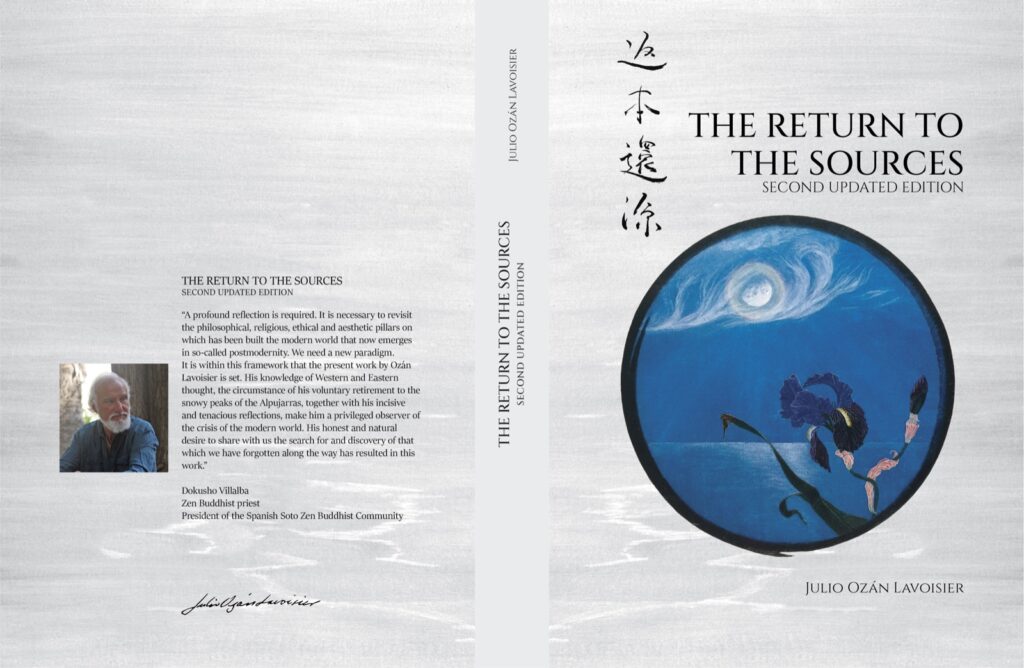There is no deeper relationship that one in which the loneliness of our existence is shared.
Inicio » RETURN TO THE SOURCES
RETURN TO THE SOURCES
(Ed. Rueda, Madrid 1993)
The coverage of this book is an oil painting on canvas of the author.
This essay is an invitation to explore the author’s methodical inner search, which consists in an ascending interrelation between psychic balance and moral demands, an exercise that results in his clarifying the religious phenomenon.
“He suggests a new use of the intellect in which, by hasting its range to its maximum, it will paradoxically lead the conscience to its own limits, thus paving the way for other forms of knowledge that will turn out to be more intuitive, more straightforward, more empathic and vindicate the subjective aspects “.
“We need a new paradigm. Fortunately, more and more thinkers –both in the Eastern and in the Western world- are consciously or unconsciously addressing their reflections towards the creation of a new paradigm.” “The work of Julio Ozán Lavoisier develops within this frame. His knowledge of western and eastern thought, the circumstance of his voluntary retreat to the snow-capped summits of the Alpujarras, together with his incisive and tenacious reflections, make him a privileged observer of the modern world crisis. His honest and natural wish to share with us the search and the discovery of what we have left behind has given origin to this work.” “These and many other questions, as interesting or more, are explained in this work thoroughly, sometimes vehemently, with the typical vehemence of someone who watches how fire spreads quickly all around and seeks to prevent our precious human existence from devastation by all means.” According to the foreword, in charge of Master Dokusho Villalba, President of the Soto Zen Buddhist Community in Spain, this essay, which has been spontaneously and synthetically written, drafts the work completed later by the philosopher.
What is the Return to the Sources? It is the rediscovery of our own Nature, of us, of the most essential aspect of our lives and of all Life; it is the recovery of a primitive point of view that will let us see things from their Essence and in their essence, a perspective that must therefore be called essential. Such essence becomes tangible and impregnates everything with Beauty, makes them luminous, literally wonderful. This is the Source of all true art, religion and philosophy. It is, in fact, the Creative itself. It is the recovery of a time we feel we have lost and therefore we long for. But that time, which we think we must look for in the distant past, is right here in our present. We can perceive it only if we manage to make time stop. Thus, it is the Immutable from which Time derives. It is the Void in things and among things, for it fills the entire space. It is the organization of our mind from where its integration follows. But this organization and integration is complete, it is universal, so much so that the mind becomes One with the universal Conscience, it is the Source of inspiration of all truly objective moral doctrine. It is Good itself that induces us to do good deeds. It is the Order that propels us to put everything in order. Everything said implies Transcendence; the Sources are the Transcendent. (From a later lecture).

THE RETURN TO THE SOURCES
Julio Ozan Lavoisier
SECOND EDITION revised
Cover: Oil painting by the author.
Calligraphy (sho) by Chiho Sato.
Both the painting and the calligraphy represent painting IX of the Return to the Sources, from The X Paintings of the Pasture of the Ox, by the Zen Master Kaku-an.
First edition: Editorial Rueda S.A. Madrid 1993
I.S.B.N. 84-7207-069-7
Legal Deposit M-15664-1993
Index
Preface to the Second Edition
Foreword by Zen Master Dokusho Villalba
Preface to the First Edition
PART ONE: Search and Find
- Reencounter
- First Doubts in Philosophy
- First Doubts in Religion
- First Doubts in Philosophy and Religion
- First Doubts in Psychology
- The Adventure
- The Natural Relationship
- Unease
- Consciousness and Discernment
- Discernment and Self
- World of Abstractions
- I Think, Therefore…
- Pilot of the Soul
- The Spirit
- Planes of Knowledge
- Contemplation and Aesthetics
- Unitive Knowledge
- Level of Consciousness
- Unitive Experience
- Life is Like a Dream
- Unity
PART TWO: Recognition and Knowledge
- Philosophy, Religion and Psychosophy
- Three Central Consciousnesses
- Unified and Unitive Consciousnesses
- Unitive Consciousness
- Unitive Faculties
- Moral Consciousness
- Religious Consciousness
- Aesthetic Consciousness
- A Schema of the Mind
- Vital or Unitive Memory
- Intellectual Plane
- Vital Plane and Internal Plane
- Objective, Subjective and Unitive Knowledge
- Two Refractions
- Mediate Unitive Consciousness
PART THREE: Morality and Religion
- Morality and Religion
- Spiritual Techniques and Psychosophy
- Living Morality
- Order
- Good and Evil
- Psychic-Moral Equilibrium or Psychosophy
- Satisfaction and Hope
- Pure or Natural Religion
- Belief and Essence
- Of Our Nature
- Intelligence
PART FOUR: Action and Conclusion
- Freedom
- Unitive Action
- Unitive and Ecological Consciousness
- Present and Future
Epilogue
Maxims and Paradoxes

